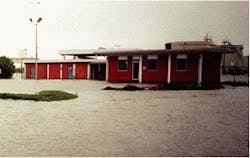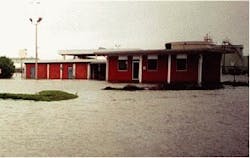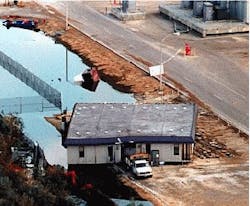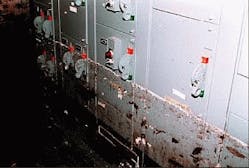When Hurricane Georges slammed into the Gulf Coast in September 1998, Chevron Products Co.'s Pascagoula, Miss., refinery was forced to shut down for 3 months, suffering millions of dollars in damages.
Wesco International Inc., Pittsburgh, mobilized its resources to help the refinery repair many of the electrical systems damaged by high waters. Wesco is a distributor of maintenance, repair, and operating products and a provider of procurement outsourcing services.
The contractor provided 24-hour assistance and deployed an array of alliance-related customer support services, such as outsourcing engineering and application expertise.
As Chevron stood to lose millions of dollars in lost production revenue, Wesco sought to minimize plant downtime and expedite the restoration of the 295,000-b/d refinery.
Figs. 1-3 show some of the damage that the Pascagoula refinery experienced from water.
Existing alliance
Even before Hurricane Georges hit the Gulf Coast, says the contractor, Chevron and Wesco had an ongoing alliance to help achieve Chevron's financial and operational goals. The sudden refinery shutdown demonstrated the significant productivity and profitability advantages of the alliance.
Wesco was prepared to serve as the electrical materials and services coordinator in an emergency mode after the hurricane. Through the established alliance relationship, Wesco understood the refinery's day-to-day operation and equipment needs. It had also established long-term relationships with Chevron personnel.
The alliance allowed for 24-hour assistance capability and the availability of an array of customer-support services on short notice. Wesco also had experience in outsourcing engineering and application expertise from within Wesco and other supplier organizations.
The Wesco-Chevron strategic alliance minimized Chevron's production loss by accelerating the refinery's return to service, says Wesco. It integrated the product and support services of multiple vendors to provide Chevron more flexibility. Also, Chevron reduced costs by purchasing new equipment to repair its electrical systems through alliance pricing.
Hurricane damage
After 17 hr of gale-force winds, water surged over the refinery's 9-ft dikes, submerging the entire plant in more than 4 ft of salt water. Chevron's instrument and electrical reliability team leader, Aubrey Hammons, reported, "We found ourselves with a facility that had no power, phones, or computers. Angie Huckeby, Wesco's outside sales representative for Chevron, was at our plant almost before the wind and water were gone. We asked that Wesco not only provide the needed electrical equipment, but also coordinate electrical equipment repairs."
The refinery suffered extensive operational damage. About 8,000 pieces of instrumentation equipment were disabled or out of service. Much of the machinery required repair or replacement. These included:
- 2 gas turbines.
- 26 centrifugal compressors.
- 3,000 motors.
- 2,100 pumps.
- 305 turbines.
- 450 gearboxes.
- 100 pieces of miscellaneous machinery.
Damage to electrical equipment included:
- Substations (7 replaced, 25 repaired).
- Motor control centers (8 replaced, 51 repaired).
- Breaker/motor starters (50 replaced, 450 repaired).
- Lighting transformers (65 replaced).
- Electric heat tracing equipment (15 miles).
- Cable (over 57 miles).
Of the refinery's 600 structures, which include buildings, sheds, trailers, 400 incurred significant damage from high winds or rising water.
According to Huckeby, as Chevron's alliance partner, Wesco was one of the first suppliers allowed into the plant. It brought in temporary lighting, extension cords, rags, cleaners, and solvents, plus large industrial fans to dry out unit substation equipment.
Since Chevron's computer system was down, the company set up an office at the facility that included online access. This enabled the company to order materials and issue them to people in the Chevron plant as they were needed.
In the first 30 days, says Wesco, it requisitioned, expedited, and delivered nearly $2 million in electrical material. After 90 days, the figures exceeded $6.5 million for materials and $6.5 million for electrical equipment repair services.
Resources
Wesco took responsibility for hiring additional staff for its nearby warehouse drivers, inside sales, and clerical help. Wesco matched Chevron's 7-day, 12-14 hr/day work week from Oct. 3 through Dec. 18.
During this period, Wesco added an on-site representative to assist Chevron's third-shift crew. Cutler-Hammer, a primary supplier of electrical equipment used by the refinery, provided personnel to supplement the Wesco staff.
Wesco district manager John Jones and national account manager Denny Finck contacted Cutler-Hammer's Engineering Systems and Services for on-site assistance. Chevron also received help from other Chevron operations and suppliers, including Crouse-Hinds, Hubbell Lighting, Bussmann Fuse, EIL Transcat, Okonite, Thomas & Betts, and Futronix.
Cutler-Hammer took project management responsibilities for electrical equipment repairs. Its services and support were integrated with those of Wesco to ensure that the refinery could resume operations quickly.
Cutler-Hammer sales engineer, Terry Holt, reported that his company's role expanded from an initial focus on switchgear replacement as Chevron looked to it for further help: "After we explained our field service capabilities, Chevron requested eight field service engineers and eight electricians. Within 2 weeks, we were asked to add more electricians and include instrumentation technicians.
"A few days later, Chevron asked us to provide engineering and AutoCAD support, as well as additional field engineering. Our on-site manpower count reached 160 with all crews working round the clock."
Cutler-Hammer's Aftermarket Center of Excellence (ACE) facilities fully reconditioned the 300+ breakers and starters damaged by the storm. Also, it provided a 2-year warranty on its work.
Alliance relationship
Wesco believes that programs like its strategic alliance program helps companies achieve productivity and profitability gains critical to remaining competitive.
Wesco President and CEO Roy Haley says, "While disasters like the Chevron refinery shutdown are not daily occurrences, they do underscore Wesco's responsibility and accountability in working with alliance partners."
From Chevron's perspective, Hammons says, "Our alliance relationship with Wesco meant we had the advantage of a one-stop-shopping approach." The alliance, according to Hammons, ultimately saved Chevron millions of dollars by enabling it to meet or improve scheduled start-up dates.



